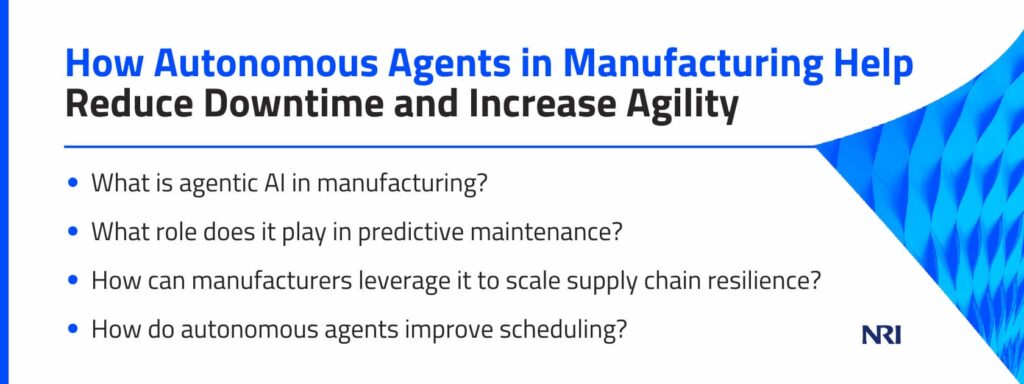Discover agentic AI applications in predictive maintenance, dynamic supply chain optimization, and on-the-fly scheduling.

Autonomous agents represent the next frontier in the evolution of artificial intelligence (AI). According to Gartner, by 2028, a third of enterprise software applications will utilize these intelligent AI systems to make 15% of the daily decisions currently made by employees. That’s a big jump from the less than 1% in 2024. Are you ready for this shift? Let’s find out.
In this article, we will explore what autonomous (agentic) AI systems are and how they differ from traditional automation and AI assistants. Outside of that, we will examine why manufacturers are embracing agentic AI to improve operational responsiveness and some of the areas where they are finding value. Keep reading.
Introducing Autonomous Agents in Manufacturing
On February 20, 1947, Alan Turing made a famous prediction about AI agents during a lecture at the London Mathematical Society, stating that we would reach a time when machines could “learn from experience” and even “alter their instructions” to achieve goals more efficiently. This idea was ahead of its time. But it’s coming to fruition.
Until recently, the primary way we’ve used AI in manufacturing has been as a manual analyst and order taker on factory floors. For instance, in the 1960s, we began with the basic automation of highly repetitive tasks, such as assembly, parts handling, and sorting, to boost efficiency and productivity.
Over time, we discovered that we could also automate inspections using AI-powered machine vision systems, allowing for better precision and quality control during production cycles.
The last two years marked another step as generative AI, or GenAI, made inroads. Now, manufacturers can train large language models (LLMs) to ingest data and create new content (e.g., summaries) based on a prompt. Many have found specific pockets of value for GenAI, such as leveraging it to upload standard operating procedures (SOPs) and maintenance manuals, thereby accelerating outcomes.
Still, something’s been missing. Autonomy.
That changes with agentic AI. These intelligent, self-driven systems perceive their environment through sensors, collect data, and perform specific functions through actuators, adapting dynamically to changing situations.
While previous AI versions thrived in structured processes, agentic AI helps you manage more complex and unstructured ones. They make decisions based on context and can proactively identify and solve problems you hadn’t previously identified. This makes agentic AI an excellent resource for various manufacturing use cases.
Have you read? Top AI Trends and Predictions 2025.
Predictive Maintenance and Real-Time Asset Monitoring
As mentioned, agentic AI systems leverage a network of sensors embedded in machinery to collect real-time data on temperature, vibration, pressure, and other operational metrics. From there, they analyze the data streams using machine learning to check for any subtle patterns that may indicate developing faults or performance degradation. If any parameter is out of shape, the autonomous agents not only notify you but also schedule maintenance during optimal windows. They will also provide step-by-step instructions on how to resolve issues effectively.
Why does this matter to the modern manufacturer? First, your enterprise can quickly act on insights provided by agentic AI to prevent downtime. Forbes estimates that the average manufacturer experiences over 15 hours of equipment downtime every week. Cumulatively, unplanned downtime costs the industry approximately $50 billion annually. Predictive maintenance can slash these costs by up to 50%, according to McKinsey. Plus, early intervention slows down wear and tear, allowing you to extend equipment lifespan by up to 40%.
Read more: How Predictive Maintenance Reduces Downtime and Costs.
Dynamic Supply Chain Optimization
So far in 2025, manufacturers have continued to experience supply chain shocks fueled by global trade tensions and geopolitical risks. This has disrupted business as usual, and leaders have a right to be concerned.
But what if you could accurately anticipate shocks? It would be game-changing. Not only would you be able to deflect disruptions, but also to enhance supply chain resilience and become more competitive.
Agentic AI integration with supply chain systems brings you closer to this reality. In this operating model, you power models with extensive data from enterprise resource planning (ERP) software, agent-to-agent interfaces with ecosystem partners, as well as external sources, including geopolitical events, market indexes, and weather reports. This allows for real-time coordination across suppliers, warehouses, and production floors. Your autonomous agent(s) can analyze external factors and current conditions to predict demand and plan supply. Furthermore, it can adapt procurement to changing market conditions through real-time dynamic sourcing and optimize inventory across SKUs by leveraging location and sensor tracking. In terms of logistics, autonomous agents can help optimize transportation with dynamic routing based on weather conditions, traffic, and market segments.
Explore: How to Strengthen Cybersecurity Foundations in the Age of AI
On-the-Fly Scheduling and Production Agility
The benefits of autonomous agents extend well beyond preventing downtime and supply chain disruptions. They can also help you:
- Automatically reassign tasks and resources based on real-time data
- Adapt schedules due to workforce availability, equipment issues, or order changes
- Support mass customization and just-in-time manufacturing
The opportunities are endless. Will you embrace them?
Preparing for Agent-Driven Operations
Before investing heavily in agentic AI, there are several key considerations to keep in mind. First, is your data ready? When it comes to implementing any form of AI, including agentic AI, the old saying, ‘garbage in, garbage out’ applies. In simple terms, you must start on a foundation of clean and high-quality data. Additionally, an optimized hybrid cloud infrastructure will also be essential when the time comes to scale your AI efforts.
Carefully consider potential ways nefarious actors could exploit your AI agents’ autonomy and decision-making capabilities, and implement mitigative controls beforehand. Finally, as AI systems can sometimes generate misleading and incorrect output, it is essential to establish robust governance with a human in the loop to ensure trust and control.
Ready to deploy intelligent agents to enhance agility, lower downtime, and future-proof operations? NRI can accelerate your path to success. We can help you identify the highest value use cases and prepare your infrastructure, data, and employees for the next stage of your enterprise’s evolution.
Schedule a custom Agentic AI readiness assessment to see what the future holds.



